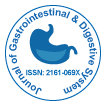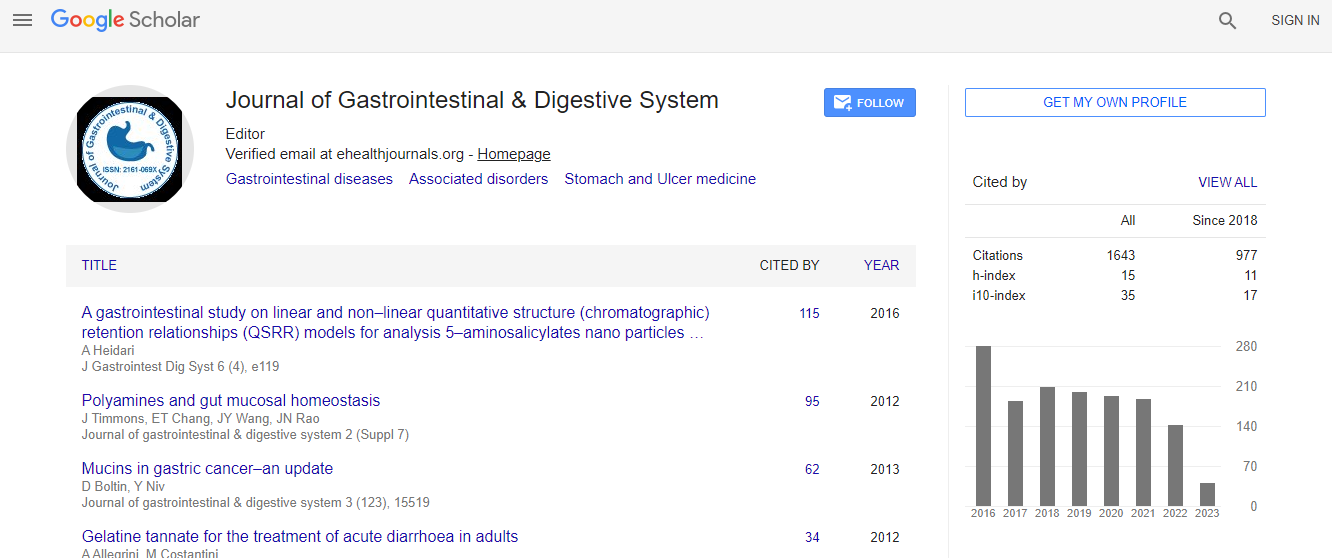Our Group organises 3000+ Global Conferenceseries Events every year across USA, Europe & Asia with support from 1000 more scientific Societies and Publishes 700+ Open Access Journals which contains over 50000 eminent personalities, reputed scientists as editorial board members.
Open Access Journals gaining more Readers and Citations
700 Journals and 15,000,000 Readers Each Journal is getting 25,000+ Readers
Google Scholar citation report
Citations : 2091
Journal of Gastrointestinal & Digestive System received 2091 citations as per Google Scholar report
Journal of Gastrointestinal & Digestive System peer review process verified at publons
Indexed In
- Index Copernicus
- Google Scholar
- Sherpa Romeo
- Open J Gate
- Genamics JournalSeek
- China National Knowledge Infrastructure (CNKI)
- Electronic Journals Library
- RefSeek
- Hamdard University
- EBSCO A-Z
- OCLC- WorldCat
- SWB online catalog
- Virtual Library of Biology (vifabio)
- Publons
- Geneva Foundation for Medical Education and Research
- Euro Pub
- ICMJE
Useful Links
Recommended Journals
Related Subjects
Share This Page
Association of glycated hemoglobin and body mass index with chronic kidney disease among type 2 diabetic patients in North-eastern Thailand
International Conference on Gastrointestinal Cancer and Therapeutics & 4th World Congress on Digestive & Metabolic Diseases & 26th Annual Congress on Cancer Science and Targeted Therapies
Sojib Bin Zaman
Charity University Medicine Berlin, GermanyKhon Kae University, Thailand
Posters & Accepted Abstracts: J Gastrointest Dig Syst
Abstract
Background: The prevalence of chronic kidney disease (CKD) amidst Thai adult type 2 diabetes mellitus (T2DM) patients is quite high. Uncontrolled DM and obesity can play a role to initiate this renal vascular complication. Glycated hemoglobin (HbA1c) a wellknown valid biomarker to estimate glycemic control. However, it is not clear whether HbA1c and body mass index (BMI) with other conventional indicators can act as a reliable determinant to predict CKD. Methods: A diabetic registry was used to collect 4042 participants from a large district hospital in the Northeast of Thailand. CKD was reported as estimated glomerular filtration rate; eGFR<60 ml/min/1.73m2. Using STATA, multiple logistic regression analysis was performed to report adjusted odds ratio. Results: More than one-fifth of T2DM patients (887, 21.9%), were found with CKD. The majority of the participants were in the poor glycemic state (82%), and 43% of them were overweight. HbA1c was found not to be a reliable indicator for CKD. Age, hypertension, microalbuminuria, and triglyceride were considered to be the implied risk factors besides HbA1c in this study. Also, BMI is seemed to decrease in the course of developing CKD. Conclusion: It appears to the presence or lack of generally accepted indicators for detecting CKD in T2DM patients. The lower values of HbA1c and BMI for high-risk CKD patients might be explained by the fact that CKD patients usually develop anemia and their nutritional status can declines. Both the contemporary guidelines of HbA1c and BMI need to be modified in consideration of CKD patients.Biography
E-mail: sojibbz@gmail.com

 Spanish
Spanish  Chinese
Chinese  Russian
Russian  German
German  French
French  Japanese
Japanese  Portuguese
Portuguese  Hindi
Hindi 
